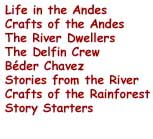

Saturday, November 18, 2000
Ranger Station 2
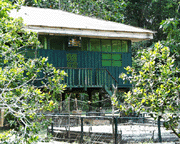
![]() What
a difference a number makes. We are spending the day at the second ranger
station up Rio Samiria. This is usually the turn around point for Tamara on
her trips. She has only been allowed to travel beyond this point a few times
and then not very far. Only researchers and rangers are allowed to go beyond
Station 2. Unfortunately, poachers make their way up this river past this
station as well. Tamara had to do some pretty tricky negotiating to get us
permits to travel to Station 5. We are getting more excited each day as we
travel further up the river knowing that there are not too many people who
ever get to see this part of the Reserve. We are extremely fortunate.
What
a difference a number makes. We are spending the day at the second ranger
station up Rio Samiria. This is usually the turn around point for Tamara on
her trips. She has only been allowed to travel beyond this point a few times
and then not very far. Only researchers and rangers are allowed to go beyond
Station 2. Unfortunately, poachers make their way up this river past this
station as well. Tamara had to do some pretty tricky negotiating to get us
permits to travel to Station 5. We are getting more excited each day as we
travel further up the river knowing that there are not too many people who
ever get to see this part of the Reserve. We are extremely fortunate.
The rangers have very little in the way of resources. They need to grow fruit and vegetables and occasionally hunt and fish to supplement the supplies they get from Iquitos. After our permits were stamped, Ranger Richard and his volunteer Henry came on board to talk with us and eat dinner with the crew. They also needed to use the boat's radio. Few of the stations have radios and theirs isn't one of them. The rangers get very lonely out here as they only get to leave and visit their families every six weeks or so. They are always happy to see Tamara.
The rangers' two dogs apparently love having Tamara visit as well. As we came in view of the station last night, they could barely contain their excitement. Tamara feeds the dogs all the leftovers while she is here, so they have come to expect good things when she comes. The rangers say the dogs know the sound of the boat. Because the boat's engine is so loud and slow, the dogs can hear it an hour before it gets there. They sit on the bank in anticipation of its arrival for the entire time.
 As
we walked around the station this morning, beautiful butterflies of all types
and sizes flew and landed around us. They apparently like the salt on our
legs and feet. There were cashew trees and flocks of blue and yellow macaws
flew overhead. For such beautiful birds, they make a heck of a racket. From
deep in the forest we could hear the "howls" of a band of howler
monkeys. If we didn't know what they were we would have thought that Godzilla
was approaching.
As
we walked around the station this morning, beautiful butterflies of all types
and sizes flew and landed around us. They apparently like the salt on our
legs and feet. There were cashew trees and flocks of blue and yellow macaws
flew overhead. For such beautiful birds, they make a heck of a racket. From
deep in the forest we could hear the "howls" of a band of howler
monkeys. If we didn't know what they were we would have thought that Godzilla
was approaching.
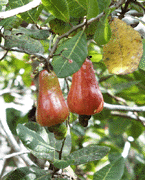
![]() Ranger
Station 2 is also noteworthy because whatever remaining bread there is gets
given to the dogs. Not quite one week out and the bread starts to mold. This
morning the cheese in our omelets had a slightly moldy taste to it as well.
We still have eight more days on the river. Soon most all of our fresh food
will either be eaten or in various stages of decay. It's a good thing Horacio
is a creative cook.
Ranger
Station 2 is also noteworthy because whatever remaining bread there is gets
given to the dogs. Not quite one week out and the bread starts to mold. This
morning the cheese in our omelets had a slightly moldy taste to it as well.
We still have eight more days on the river. Soon most all of our fresh food
will either be eaten or in various stages of decay. It's a good thing Horacio
is a creative cook.
Because our bodies are not use to this environment, we are very susceptible to intestinal disorders. Horacio knows how to prepare the food carefully to keep us healthy. Even with all his care, Susan is "boat bound," as we call it. She doesn't dare get very far from the bathroom. Horacio made a broth soup with noodles for her as a reprieve from the rice and crackers she has been eating for far too many meals. We carry antibiotics and other medicine with us because we are too far away to get to any doctors quickly. Last year Tracy came home with both amoebic dysentery and giardia. It is important to treat these ailments seriously when they occur.
Today is a rest day for us—which doesn't mean that we rest. No not us! There is too much to see. Instead we just wonÕt be counting dolphins today.
Night Rides and Jungle Walks
Last night we finally got to go out on the skiff because it has stopped raining. Captain Antonio guided the boat along the shore and shinned a huge flashlight so that we could see any animals that might be active. There were many caiman. Most of them were small but judging from the size of their heads, a few of them were 2 meters or more. We definitely didn't want to get out of the boat.
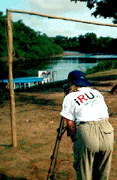 This
morning Tamara, Enzo, Shelly, Mike and Geoff went on a walk through the forest
behind the station. Tracy and Susan stayed behind to photograph the station
and do a QuickTime Virtual Reality movie (QTVR) of the area.
This
morning Tamara, Enzo, Shelly, Mike and Geoff went on a walk through the forest
behind the station. Tracy and Susan stayed behind to photograph the station
and do a QuickTime Virtual Reality movie (QTVR) of the area.
While in the forest we were surrounded by hardwood trees that have huge buttress roots. Their size keeps them from falling over when the river water is high and floods the forest floor. The most exciting part was going into the old growth forest further from the riverbank. We had never seen the difference between the old and new growth. In the old growth forest, the trees are taller and there is very little undergrowth. Once an old growth forest is cleared it takes years for it to mature. You can see the high water mark on the trees in the forest. It is amazing how high the water gets.
River Bath
Once the hikers were back from their walk everyone washed themselves and their clothes in the river. This was essential for those who had gone on the walk because there are chiggers in the forest that burrow into your skin. Washing gets them off. Tamara and Enzo both got them the other day when they delivered the coloring books to a school in one of the villages.
Washing in a river with a bit of a current is a challenge. We giggled quite a bit as we tried to wash ourselves without floating away. We were certain that at one point we were going to have to report that the last time we saw Shelly she was "sudsy and heading south."
Taricayas
One of the conservation projects here in the Reserve is the preservation of the Podocnemis unifilis or yellow side-necked turtles. They get their name because they have a little yellow on them and because they can't retract their heads into their shells. Instead they turn their heads sidewise up against their shells. Turtle eggs are considered a delicacy in the jungle and in Iquitos. Although protected, poachers come into the Reserve to dig up the eggs and take the female turtles back to Iquitos to sell in the market. When we visited the market last year there were many turtles and eggs for sell.
To protect the turtles, the rangers dig up the eggs and bring them back to the station. They have a special raised bed where they bury them, 25 in each hole, for approximately 65 days. They must bury them at the same depth and turned the same way as they found them. The temperature at which the eggs are incubated determines the gender of turtles. The eggs closer to the middle of the clutch incubate at a higher temperature. To keep the species balanced the rangers need to do their best to ensure that both male and female turtles hatch. They mark each egg as they unbury it.
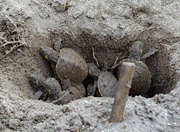
![]() After
65 days the rangers uncover the eggs. Where once there were eggs, baby turtles
come scurrying out of the holes and head as fast as they can towards the river.
To give the turtles a better chance at survival, the rangers gather them up
and keep them in buckets of water until their egg sacs come completely off.
The rangers put river "lettuce" in the tubs for the turtles to feed on. Once
the turtles are a little larger they are released into the water.
After
65 days the rangers uncover the eggs. Where once there were eggs, baby turtles
come scurrying out of the holes and head as fast as they can towards the river.
To give the turtles a better chance at survival, the rangers gather them up
and keep them in buckets of water until their egg sacs come completely off.
The rangers put river "lettuce" in the tubs for the turtles to feed on. Once
the turtles are a little larger they are released into the water.
This morning we got to help the rangers unbury and gather over 100 turtles. We were amazed by how strong their flippers were against our hands and at how intent they were in getting to the river. Most instinctively knew which direction the river was. A few were a little confused and probably wouldn't have made it. One or two were deformed and there were a few eggs remaining that didn't hatch.
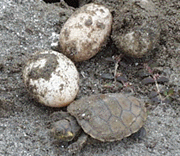 Fortunately
for us, the baby turtles that had hatched a week ago and were being kept in
the tubs of water were ready to be released. The rangers prefer to release
the turtles on a beach that is more protected from predators than the one
in front of the station. Because it takes the rangers hours to paddle their
dugout canoe to this particular beach, they asked if we would tow them and
the turtles up river and help them release them. Once on the beach we each
took handfuls of baby turtles from the tubs and let them go on the sand. Some
of them scurried right into the water, others looked dazed and had to be prodded
along.
Fortunately
for us, the baby turtles that had hatched a week ago and were being kept in
the tubs of water were ready to be released. The rangers prefer to release
the turtles on a beach that is more protected from predators than the one
in front of the station. Because it takes the rangers hours to paddle their
dugout canoe to this particular beach, they asked if we would tow them and
the turtles up river and help them release them. Once on the beach we each
took handfuls of baby turtles from the tubs and let them go on the sand. Some
of them scurried right into the water, others looked dazed and had to be prodded
along.
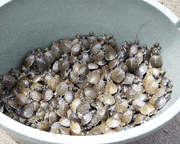
![]() It
took us close to a half an hour to release the hundreds of turtles from the
tub. We will never know how many of those turtles survive, if any. Yet we
all stood in awe as these tiny little creatures made their way to the river
and swam out of sight. With so many species threatened or endangered it is
difficult not to be moved by how fragile these new lives are. And, at the
dedication of the people are who are helping to protect them no matter how
insignificant their efforts may seem.
It
took us close to a half an hour to release the hundreds of turtles from the
tub. We will never know how many of those turtles survive, if any. Yet we
all stood in awe as these tiny little creatures made their way to the river
and swam out of sight. With so many species threatened or endangered it is
difficult not to be moved by how fragile these new lives are. And, at the
dedication of the people are who are helping to protect them no matter how
insignificant their efforts may seem.



